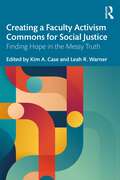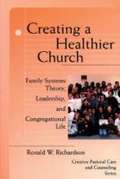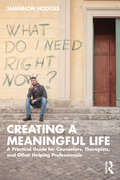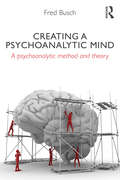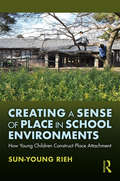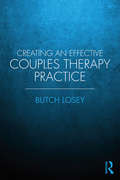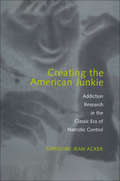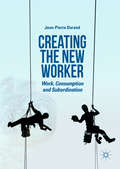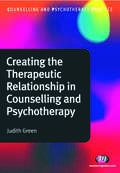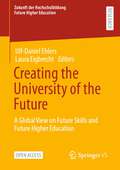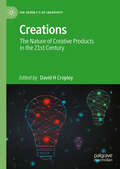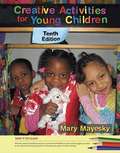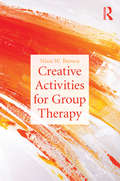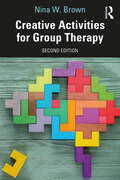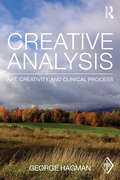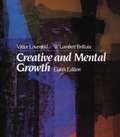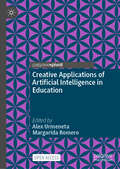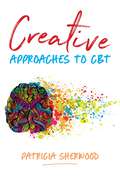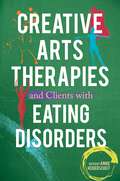- Table View
- List View
Creating Your Future After a Toxic Relationship: A Coaching Workbook
by Dee WilkinsonWhen you find yourself alone after a relationship breakdown and the future you once had planned has evaporated, where and how do you start to create a new future? This book can be used by the reader individually or with a life coach alongside, to support the individual in creating the first steps towards a new future and a ‘road map’ on how to get there. Dee Wilkinson uses a coaching approach throughout the workbook, taking the reader through a logical 10-step process to design a brighter future that will be in line with their authentic self. There are exercises, tools and techniques for the reader to work through to help them understand themselves fully, therefore creating better long-term decision making. A life coach can also use the resource to support the reader’s journey through the steps by asking coaching questions and offering insights and challenges as necessary to keep the reader on track. Many texts are aimed at helping people understand the psychology of why they were in a relationship, whereas this workbook enables people to take tangible steps to move on with their lives. It will be of great help to individuals seeking to move on from toxic relationships, as well as life coaches and other mental health professionals.
Creating Your Professional Path: Lessons from My Journey
by Gerald CoreyIn this book for graduate students and new counselors, Gerald Corey writes about personal and professional experiences throughout his 50-year career as a counselor, teacher, counselor educator, psychologist, supervisor, and writer.
Creating a Coaching Culture for Managers in Your Organisation (Essential Coaching Skills and Knowledge)
by Dawn Forman Mary Joyce Gladeana McMahonCreating a Coaching Culture for Managers in your Organisation is for managers leaders and coaches interested in extending the practice of coaching to achieve broader organisational outcomes. The book offers a practical approach on how to use coaching strategically to create a culture that supports change, builds leadership capacity, and achieves a high degree of alignment between the goals and aspirations of organisations, and their staff. The authors provide rich case study examples of how coaching has been used in a range of organisations to build capacity, leadership learning, and support new ways of working. Taken together, the chapters provide insight into how organisations can develop a culture that promotes engagement, open and dialogic communication, clarity of expectations, and high performance. This valuable text is a timely contribution to current thinking on leadership, management, and organisation development. It will be of interest to managers, leaders, HR professionals and coaching professionals, as well as students interested in coaching techniques, counsellors, and psychotherapists.
Creating a Faculty Activism Commons for Social Justice: Finding Hope in the Messy Truth
by David L. Andrews Steven J. JacksonThis timely book shines a light on social justice activism within higher education, calling for a conceptual space of faculty activism to share and build on the work of others who came before.Written by expert social justice academics, this volume provides a collection of honest, critically reflective personal narratives by those who are leading systemic change within their institutions. The faculty authors share openly about their experiences, motivations, challenges, alliances, hopelessness, hopefulness, and what they wish they had known from the start. Topics include addressing systemic racism, changing discriminatory academic policies, establishing resources for historically marginalized students, advocating for a more diverse faculty and staff, educating the campus about bias, among others. This book empowers social justice academics to navigate the complexities of institutional procedures, recognize invisible walls that slow progress, and curate coalitions for systemic change.Uniquely addressing the joys and challenges of creating systemic change, the book will be essential reading for faculty involved in social justice activism within their universities and colleges. The book will also be relevant for all those in the fields of social justice, community engagement, critical higher education, psychology, and sociology.
Creating a Healthier Church: Family Systems Theory, Leadership, and Congregational Life
by Ronald W. RichardsonAn introduction to the Bowen Family Systems Theory and its applications both to church life and to the role of leadership in creating a healthier church, this book explains the complexities of congregational emotional life in understandable language.
Creating a Meaningful Life: A Practical Guide for Counselors, Therapists, and Other Helping Professionals
by Shannon HodgesCreating a Meaningful Life builds on the tenets of mindfulness-based cognitive therapy (MBCT) to answer some of life’s basic questions, such as "How do I create a meaningful, purposeful life?" and "Is the life I am living one that brings me fulfillment, purpose, and a sense of inner peace?" Using a variety of techniques, including journaling, grounding exercises, cognitive self-talk restructuring, and more, chapters invite counseling professionals and students to explore their inner landscape, better understand themselves and find communion with others.
Creating a Psychoanalytic Mind: A psychoanalytic method and theory
by Fred BuschBringing a fresh contemporary Freudian view to a number of current issues in psychoanalysis, this book is about a psychoanalytic method that has been evolved by Fred Busch over the past 40 years called Creating a Psychoanalytic Mind. It is based on the essential curative process basic to most psychoanalytic theories - the need for a shift in the patient's relationship with their own mind. Busch shows that with the development of a psychoanalytic mind the patient can acquire the capacity to shift the inevitability of action to the possibility of reflection. Creating a Psychoanalytic Mind is derived from an increasing clarification of how the mind works that has led to certain paradigm changes in the psychoanalytic method. While the methods of understanding the human condition have evolved since Freud, the means of bringing this understanding to patients in a way that is meaningful have not always followed. Throughout, Fred Busch illustrates that while the analyst's expertise is crucial to the process, the analyst's stance, rather than mainly being an expert in the content of the patient's mind, is primarily one of helping the patient to find his own mind. Creating a Psychoanalytic Mind will appeal to psychoanalysts and psychotherapists interested in learning a theory and technique where psychoanalytic meaning and meaningfulness are integrated. It will enable professionals to work differently and more successfully with their patients.
Creating a Sense of Place in School Environments: How Young Children Construct Place Attachment
by Sun-Young RiehCreating a Sense of Place in School Environments guides its readers to the characteristics that tend to generate a sense of place through children’s vivid descriptions of their school and provides a body of critical information that can be employed to design a better school environment that can imprint cherished childhood memories. The childhood school environment calls for special attention regarding the sense of place it creates. The sense of place in childhood both affects children's current quality of life and frames their lasting world view. It is well known that children's cognitive development is closely related to their place attachment to their surroundings, and that children’s adaptation to a given environment depends on how such place attachment can be created. Therefore, it is natural that people’s identity in the world is the accumulation of their experience of place while in childhood. Cross-checking between the imprint of adults' memories of places in school and children’s current "lived experience" of their favorite school place confirmed that certain spatial configurations, which the author herein refers to as "place generators" can generate positive attributes of physical settings that construct a sense of place and last as lifelong memories. It is an ideal read for academics, students, and professionals.
Creating an Effective Couples Therapy Practice
by Butch LoseyMost clinicians seek guidelines and indicators as to the effectiveness of their interventions with clients. Some may even be implementing evidence-based interventions and seek an in-depth understanding of their results. This book helps clinicians who provide couple’s or marriage therapy and counseling go from the ambiguous realm of "thinking" or "knowing" their effectiveness to being able to demonstrate it. It identifies effective strategies for common treatment concerns that connect to the successful outcomes of therapy. Here, the process starts even before the couple enters therapy and goes beyond the final session. Dr. Losey discusses specific outcome measures and how they can be used in session so that the couple can assess their relationship and develop specific goals and interventions for treatment. The author also examines session notes, pre-treatment change, and developing quality post-treatment goals in his discussion of clinical effectiveness.
Creating an Inclusive School Climate: A School Psychology Model for Supporting Marginalized Students
by Tamika P. La Salle-FinleyCreating an Inclusive School Climate introduces school psychology stakeholders to a wealth of foundations, individualized experiences, and school improvement efforts intended to bolster the outcomes of our most vulnerable learners. As student populations grow increasingly diverse, sociocultural variables have never been more important to supporting school climate. Using an original cultural-ecological framework, this book builds on the experiences of historically underrepresented and oppressed youth to foster a socially just, strengths-based perspective for implementing school improvement efforts within multi-tiered systems. Faculty, graduate students, researchers, and professionals in the field will come away with a conceptually and methodologically sound understanding of the interrelationships between personal characteristics, culture, ecological contexts, and school climate.
Creating the American Junkie: Addiction Research in the Classic Era of Narcotic Control
by Caroline Jean AckerHeroin was only one drug among many that worried Progressive Era anti-vice reformers, but by the mid-twentieth century, heroin addiction came to symbolize irredeemable deviance. Creating the American Junkie examines how psychiatrists and psychologists produced a construction of opiate addicts as deviants with inherently flawed personalities caught in the grip of a dependency from which few would ever escape. Their portrayal of the tough urban addict helped bolster the federal government's policy of drug prohibition and created a social context that made the life of the American heroin addict, or junkie, more, not less, precarious in the wake of Progressive Era reforms.Weaving together the accounts of addicts and researchers, Acker examines how the construction of addiction in the early twentieth century was strongly influenced by the professional concerns of psychiatrists seeking to increase their medical authority; by the disciplinary ambitions of pharmacologists to build a drug development infrastructure; and by the American Medical Association's campaign to reduce prescriptions of opiates and to absolve physicians in private practice from the necessity of treating difficult addicts as patients. In contrast, early sociological studies of heroin addicts formed a basis for criticizing the criminalization of addiction. By 1940, Acker concludes, a particular configuration of ideas about opiate addiction was firmly in place and remained essentially stable until the enormous demographic changes in drug use of the 1960s and 1970s prompted changes in the understanding of addiction—and in public policy.
Creating the New Worker: Work, Consumption and Subordination
by Jean-Pierre DurandThis book explores the relationship between the changing nature of capitalism and the creation of the new worker. In a changing global economy, work - as the activity that structures individuals in capitalism both socially and psychologically - is being undermined. Combining a Gramscian critique of contemporary patterns of capitalist labour control with Lacanian psychoanalysis, Durand examines what kinds of human beings are emerging in and through modern work, or on its margins. Creating the New Worker will be of interest to students and scholars who engage in the sociology and psychology of work, economics, and labour.
Creating the Therapeutic Relationship in Counselling and Psychotherapy (Counselling and Psychotherapy Practice Series)
by Judith A. GreenAt the centre of good counselling and psychotherapy practice is the relationship between therapist and client. This book is an essential guide for counselling and psychotherapy students who want to explore the personal qualities and attitudes of the therapist, and to allow the client to engage in the therapeutic process with trust. The book will consider how students of counselling can develop these qualities and enhance their awareness of their attitudes, to enable them to be fully present and emotionally available in their encounters with clients.
Creating the University of the Future: A Global View on Future Skills and Future Higher Education (Zukunft der Hochschulbildung - Future Higher Education)
by Ulf-Daniel Ehlers Laura EigbrechtThis open access publication presents a global panorama of institutional strategies, academic programs, scholarly insights as well as teaching and learning practices taking stock of the Future Skills Turn taking place in higher education. Future Skills have evolved to be one of the most important priorities for the development of higher education institutions globally. Students and graduates learn how to acquire Future Skills for their lives and careers and for shaping societies towards more sustainable futures. Institutions, teachers and policy makers gain insights into strategies to shape the Future Skills Turn in higher education and create the University of the Future.
Creation Myths: Revised Edition
by Marie-Louise von FranzCreation myths are the deepest and most important of all myths because they are concerned with both the basic patterns of existence and the ultimate meaning of life. In this book, an eminent Jungian analyst examines the recurring motifs that appear in creation myths from around the world and shows what they teach us about the mysteries of creativity, the cycles of renewal in human life, and the birth of consciousness in the individual psyche. Among the topics discussed are: • Why the creative process is often accompanied by anxiety, depression, loneliness, and fear of the unknown. • The meaning of creation motifs such as the egg, the seed, the primordial being, the creative fire, the separation of heaven and earth, and the four stages of creation. • Creation symbolism in the alchemical opus of medieval tradition. • How creation-myth motifs appear in the dreams of people who are on the verge of a leap forward in consciousness.
Creations: The Nature of Creative Products in the 21st Century (The Seven C’s of Creativity)
by David H CropleyThis edited book explores creative products (i.e. Creations) as part of the seven C's of creativity framework. Through nine chapters, leading scholars in the field explore five different domains (education, crime/terrorism, music, science and engineering) addressing the nature of the creations in each given domain, and the criteria by which creations in that domain are judged. Drawing together key, underpinning concepts from the science of creativity, the book delves into the history of creativity research applied to products to then explore new concepts that are impacting on research, especially the role of artificial intelligence in supporting the development and assessment of creative products.
Creative Activities For Young Children (Tenth Edition)
by Mary MayeskyCREATIVE ACTIVITIES FOR YOUNG CHILDREN, 10th Edition, is a terrific book filled with fun, creative, and easy-to implement activities for young children. You'll be encouraged to exercise your own creativity, as well as learn how to help young children do the same. Hundreds of activities, up-to-date research, recipes, finger plays, information on how to select children's books, and more make this book an invaluable resource for you and others planning to work creatively with children across the curriculum--and one you'll want to keep for use throughout your professional career.
Creative Activities for Group Therapy
by Nina BrownLeading a group is a delicate balancing act of tasks and dynamic group and individual factors, and the group leader’s expertise and skill are fundamental to maintaining this balance. However, no matter how competent and well-prepared the group leader is, there can be situations that present challenges that are not easily addressed, defy conventional interventions, or call for a different approach. The material presented in this book is intended to give group leaders evidence-based creative and inspirational tools, techniques, intervention strategies, and the like to address these dilemmas and difficult situations. They can also enhance members’ growth and development, stimulate self-exploration, assist to soothe and calm, and deepen and broaden thoughts and feelings. The creative activities included were selected because they do not require specialized training, are easy to implement, do not follow a particular theoretical perspective, and can be effective for both the individual and group as a whole. The major categories of expressive processes presented are fairy tales; drawing; writing; imagery and mindfulness; music; movement, exercise, dance, drama, and role play; and collage, flats, and scrapbooks. Each chapter will focus on one of these activities and is designed so that they can be completed in one session. The closing chapters will present applications for member’s concerns, group level challenges, and case examples of group dilemmas and suggested activities to address them.
Creative Activities for Group Therapy
by Nina W. BrownThe second edition of Creative Activities for Group Therapy focuses on evidence-based alternatives for verbal expression in group therapy, which provides group leaders with innovative inspirational tools, techniques, and intervention strategies to address dilemmas and difficult situations and help encourage members’ self-exploration and self-disclosure. Newly organized into three categories, the book covers group basics and fundamentals, categories for activities, and a new section on diverse settings, conditions, and applications. The first section outlines use of activities, benefits to groups, and tips for effective and safe use of creative activities. Section two covers a range of creative activities for leaders to implement, such as art therapies, movement therapies, writing therapy, and includes new activities for virtual sessions. The new section then addresses activities for diverse settings such as groups in hospitals and prisons, various medical conditions and psychological states, and inclusive applications that minimize group conflict and promote emotional expression. This new edition provides mental health professionals and students, including therapists, counselors, and clinical social workers, with a wide array of methods for enriching their therapy groups and tools for implementing these activities.
Creative Agency (Palgrave Studies in Creativity and Culture)
by Dan HarrisThis book offers a socio-cultural examination of contemporary creativity studies. Drawing heavily on posthumanist, new materialist and affective theoretics, the author argues in favour of an expansive and sustainable approach to creativity which contributes to an emergent ‘creativity studies’ inter-discipline. It seeks to establish a broader consideration of creativity in socio-culture, that extends beyond, or indeed refutes, the narrowing aperture of entrepreneurship and innovation as synonyms for creativity in economic, cultural and educational contexts and discourses. Drawing on multiple case studies of creative relational and creative ecological empirical research, this book integrates a concern for personal, planetary and geo-political collaboration, as an antidote for ‘innovation for innovation’s sake’.
Creative Analysis: Art, creativity and clinical process (Psychoanalytic Inquiry Book Series)
by George HagmanCreative Analysis: Art, Creativity and Clinical Process explores the dynamics of creativity in psychoanalytic treatment. It argues that the creative process of the analytic interaction is characterized by specific forms of feeling, thinking and most importantly, relating that result in the emergence of something new – therapeutic change. The artistic aspects of psychoanalysis and various features of creativity in analytic treatment are explored. Clinical examples are discussed at length. George Hagman presents a new model of the psychology of creativity and art that helps us to better understand the clinical process. The book explores and develops several important implications of Hagman’s main thesis: the psychodynamics of art, the creativity of the brain, aesthetic aspects of the treatment relationship, the creativity of the analyst and analysand. Change in analysis is driven not just by the analyst’s interventions but the patient’s own motivation and capacity for self-transformation. This change is depicted here as a depth psychological process which explores the sources of the patient’s resistance to self-actualization and identifies hidden potential, unrealized capacities and strengths. Creative Analysis: Art, Creativity and Clinical Process reformulates psychoanalytic therapy as a form of art that can help patients realize their potential which may have been blocked, inhibited, denied or derailed. The book will be of interest to psychoanalysts, psychotherapists, graduates and students, including the educated public interested in art.
Creative And Mental Growth
by Viktor Lowenfeld W. BrittainChildren are the essence of this book, but more than that, they are the essence of society. Creative and intellectual growth are the basis of any educational system, and it is the hope that this book can contribute to an understanding of the importance of this area so as to make the education of children a joyful and meaningful experience.
Creative Applications of Artificial Intelligence in Education (Palgrave Studies in Creativity and Culture)
by Margarida Romero Alex UrmenetaThis open access book explores the synergy between AI and education, highlighting its potential impact on pedagogical practices. It navigates the evolving landscape of AI-powered educational technologies and suggests practical ways to personalise instruction, nurture human-AI co-creativity, and transform the learning experience. Spanning from primary to higher education, this short and engaging volume proposes concrete examples of how educational stakeholders can be empowered in their AI literacy to foster creativity, inspire critical thinking, and promote problem-solving by embracing AI as a tool for expansive learning. Structured in three parts, the book starts developing the creative engagement perspective for learning and teaching to then present practical applications of AI in K-12 and higher education, covering different fields (teacher education, professional education, business education) as well as different types of AI supported tools (games, chatbots, and AI assisted assessment). It also delves into the ethical considerations, policy implications, and the central role educators play in harnessing the power of an AI informed educational experience.
Creative Approaches to CBT: Art Activities for Every Stage of the CBT Process
by Patricia SherwoodExpanding the therapist's toolkit, this book provides creative activities and exercises for every stage of the cognitive behavioural therapy (CBT) process, from initial diagnosis through to relapse prevention. The exercises are an integrated part of the CBT work and assist in the process of acquiring the required skills and behavioural outcomes. Drawing on creative techniques such as clay therapy and guided imagery, each chapter focuses on a different stage or element of the CBT process and provides creative exercises to enhance the work, with clear step-by-step instructions and case examples.
Creative Arts Therapies and Clients with Eating Disorders
by Geri Giebel Chavis Susan M. Clark Katrina Mcferran Anda Upmale Gro Trondalen Laura Wood Indra Majore-Dusele Sarah Kipnis Leah Wellstone Simona Orinska Rhonda Guertin Stacy Saindon Nona Cameron Tamar Melmed-Marmor Barbara Nordstrom-Loeb Erin Gargaro Annie Heiderscheit Kristine Vende Sarah PunchDrawing on the expertise of leading creative arts therapists from around the world, this book provides a comprehensive examination of the role of the creative arts in the treatment of clients with eating disorders (EDs). The book explores how art, dance and movement, drama, music, and poetry therapies have fostered insights, growth, and recovery for patients across ED diagnoses (anorexia nervosa, bulimia nervosa, binge eating disorder and compulsive overeating disorder), and comorbid diagnoses. It illustrates how each creative arts modality is implemented in the ED treatment process and covers a variety of treatment levels (residential, inpatient, intensive outpatient and outpatient). Each chapter is enriched with case illustrations to provide a greater depth of understanding of how the methods are used in clinical practice. This book is an incomparable overview of the value and diverse uses of the creative arts in the treatment of EDs, and it will be of interest to all arts therapists, psychodrama therapists, family therapists, as well as students of these disciplines.



